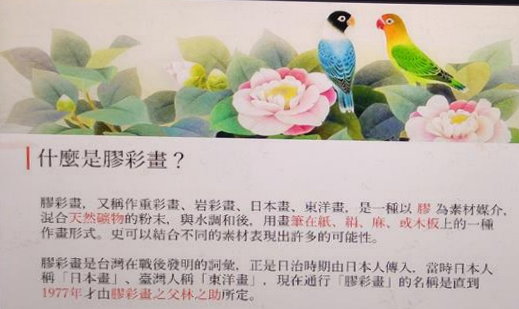Gouache
It's a style of painting which uses glue.
Actually, "Gouache Painting" was named in the World War 2 by "The Father of Gouache", Lin Chih-Chu. It's name used to be "Heavy color painting", "Rock painting", "Japanese painting" or "Toyoga". It's materials are animals collagen and pigments. The pigments can be divided into rock painting, laminar and other materials. These can improve or change the paintings' appeared effect. The painting tools are very complex and expensive, so "Gouache" isn't very common. It's advantages are it can last longer than watercolor, it's retains vibrancy to fade and is mould resistant.
|

|
|
from:More Art Gallery
|
|
Definition:
The paint which is made with glue(cowhide collagen, deer collagen or fish collagen) as the medium and colored with mineral pigments, such as calcium carbonate pigments, botanical pigment and metal pigments. Gouache was given it's name by Professor Lin Chih-chu in 1977.
History
1.Ancient China (ancient ~ Sui and Tang Dynasties)
In the Neolithic years, people already know how to use mix glue with ore or soil to paint. It can be seen that in the Neolithic Age, in China, this technique was already in use. The Sui and Tang Dynasties were the heyday of the art of Danqing. In the late Tang Dynasty, Mr. Zhang Yan Yuan repeatedly used "Danqing" to represent a kind of art that is very similar to gouache. This is the earliest and most concrete record of silks, paints, glues and pens being used to paint in the gouache style.
2.Ancient China (Song ~ Qing)
The Huizong period was a brilliant era in the history of Chinese painting. Various styles and techniques coexisted. However, gouache paintings gradually declined at this time and could not compete with the later Chinese brush paintings.
By the end of the Yuan Dynasty, Chinese brush painting became the mainstream, leading to the declinelof gouache painting. In the early Qing Dynasty and the heyday Qing period, there were signs of recovery due to strong national economic prosperity. Although being belittled by scholars, this style of painting not only prevailed in the court, but also affected the folk New Year paintings. It was not until the Opium War that the country gradually weakened and Chinese brush painting became mainstream again.
3.Japanese occupation period
Taiwan's art did not start to sprout until the late Qing Dynasty and gradually developed during the Japanese occupation period. Its development was caused by the development of Japanese colonial culture and education environment. Most of these artists studied their art courses in public schools and junior high schools at the time, and sprout their expertise and interest in painting. Those first generation Taiwanese painters also won prizes in the Taiwan Exhibition organized by the Government of Taiwan in 1927, which was an imitation the official exhibition in Japan. At the time, most of the painters selected for the exhibition at the show were Japanese artists. However, only three young artists Mrs. Chen Chin, Mr. Lin Yu Shan and Mr. Kuo Hsueh Hu were accepted. Everyone was shocked and the three were hailed as "Taiwan's Three Youths." In addition to creating outstanding works, these excellent painters taught their skills to others and thus contributed to the vigorous development of gouache in Taiwan.
4.Modern Taiwan
Since the creation of the "Taiwan Exhibition" in 1927, a new generation of painters with TOEI Institute’s educational background had become promoters of the new movement of sketching and painting during this time. The surge in development was not until the "Provincial Exhibition" changed the name of "Oriental painting department" to "Chinese painting department." After the war, a large number of conservative Chinese brush painters from the Central Plains became the provincial exhibition expo board and created a so-called "orthodox painting" dispute that lasted for nearly ten years. As a result, the cultivation of talented people led to decades of sterility. In 1985, the Department of Fine Arts of Tokai University invited Prof. Lin Chih Chu who graduated from Musashino Art University in Japan to give lectures on gouache painting, so that the college education of gouache painting in Taiwan could officially start. Gouache painting is thriving well all over Taiwan, providing support through open competitions and artists observing each other in joint exhibitions as an opportunity to encourage creativity and achieve the desired effect of enhancing the artistic level of gouache painting.
